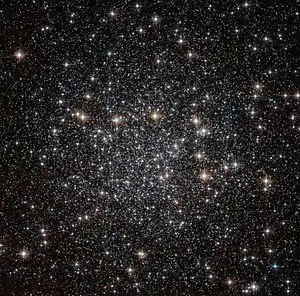NGC 4833
NGC 4833 (also known as Caldwell 105) is a globular cluster discovered by Abbe Lacaille during his 1751-1752 journey to South Africa, and catalogued in 1755. It was subsequently observed and catalogued by James Dunlop and Sir John Herschel whose instruments could resolve it into individual stars.
| NGC 4833 | |
|---|---|
 NGC 4833 is one of the over 150 globular clusters known to reside within the Milky Way.[1] | |
| Observation data (J2000 epoch) | |
| Class | VIII[2] |
| Constellation | Musca |
| Right ascension | 12h 59m 33.92s[3] |
| Declination | –70° 52′ 35.4″[3] |
| Distance | 21.5 kly (6.6 kpc)[4] |
| Apparent magnitude (V) | +7.79[5] |
| Apparent dimensions (V) | 13′.5 |
| Physical characteristics | |
| Mass | 4.10×105[4] M☉ |
| Radius | 42 ly[6] |
| Metallicity | = –1.71[7] dex |
| Estimated age | 12.54 Gyr[7] |
| Other designations | Caldwell 105, GCl 21,[5] Lacaille I.4 Dunlop 164, Bennett 56 |

The location of NGC 4833 (labelled in red)
The globular cluster is situated in the very southerly constellation Musca at a distance of 21,200 light years from Earth. It is partially obscured by a dusty region of the galactic plane. After corrections for the reddening by dust, evidence was obtained that it is in the order of 2 billion years older than globular clusters M5 or M92.
See also
References
- "A sky full of stars". www.spacetelescope.org. Retrieved 1 August 2016.
- Shapley, Harlow; Sawyer, Helen B. (August 1927), "A Classification of Globular Clusters", Harvard College Observatory Bulletin, 849 (849): 11–14, Bibcode:1927BHarO.849...11S.
- Goldsbury, Ryan; et al. (December 2010), "The ACS Survey of Galactic Globular Clusters. X. New Determinations of Centers for 65 Clusters", The Astronomical Journal, 140 (6): 1830–1837, arXiv:1008.2755, Bibcode:2010AJ....140.1830G, doi:10.1088/0004-6256/140/6/1830.
- Boyles, J.; et al. (November 2011), "Young Radio Pulsars in Galactic Globular Clusters", The Astrophysical Journal, 742 (1): 51, arXiv:1108.4402, Bibcode:2011ApJ...742...51B, doi:10.1088/0004-637X/742/1/51.
- "NGC 4833". SIMBAD. Centre de données astronomiques de Strasbourg. Retrieved 2006-11-17.
- distance × tan( diameter_angle / 2 ) = 42 ly. radius
- Forbes, Duncan A.; Bridges, Terry (May 2010), "Accreted versus in situ Milky Way globular clusters", Monthly Notices of the Royal Astronomical Society, 404 (3): 1203–1214, arXiv:1001.4289, Bibcode:2010MNRAS.404.1203F, doi:10.1111/j.1365-2966.2010.16373.x.
- CCD Photometry of the Globular Cluster NGC 4833 and Extinction Near the Galactic Plane, Melbourne et al., 25 September 2000, Astrophysical Journal
External links
| Wikimedia Commons has media related to NGC 4833. |
- Basic information and data
- Photographed by the Antilhue amateur astronomical observatory
- CCD Photometry of the Globular Cluster NGC 4833 and Extinction Near the Galactic Plane
- Position relative to nearby cluster NGC 4372
- NGC 4833 on WikiSky: DSS2, SDSS, GALEX, IRAS, Hydrogen α, X-Ray, Astrophoto, Sky Map, Articles and images
This article is issued from Wikipedia. The text is licensed under Creative Commons - Attribution - Sharealike. Additional terms may apply for the media files.